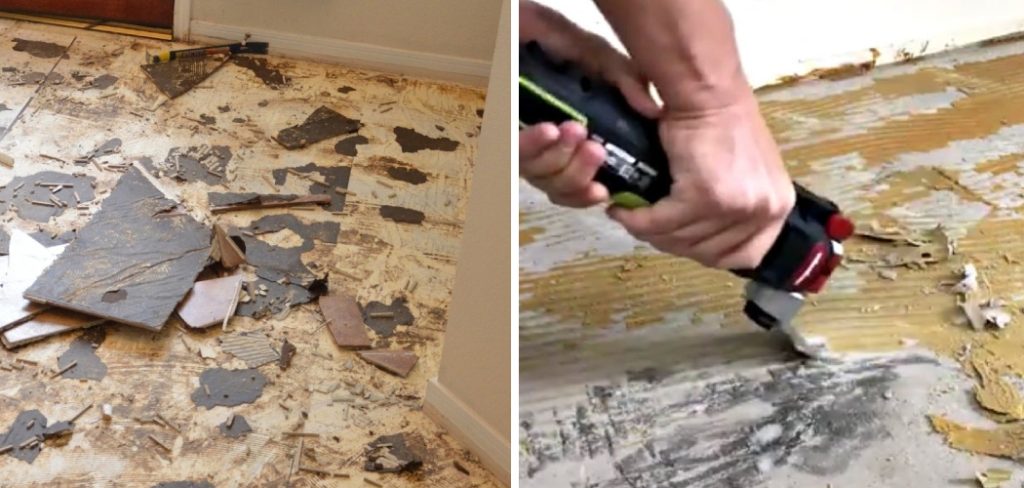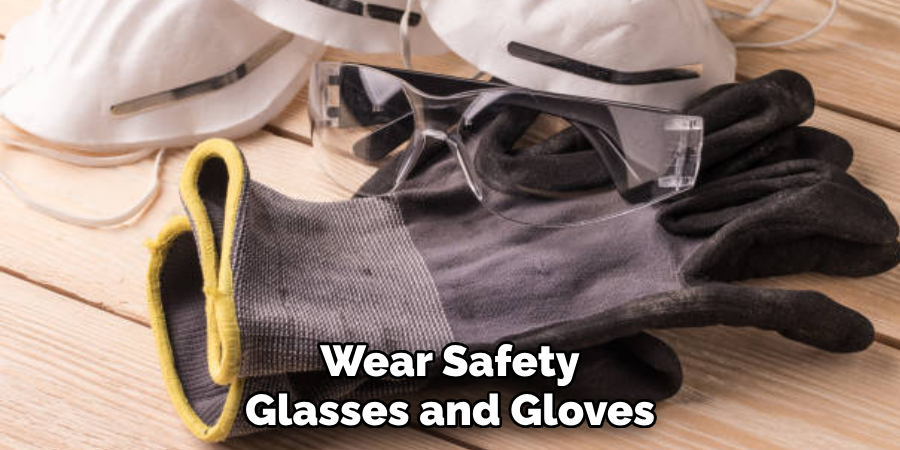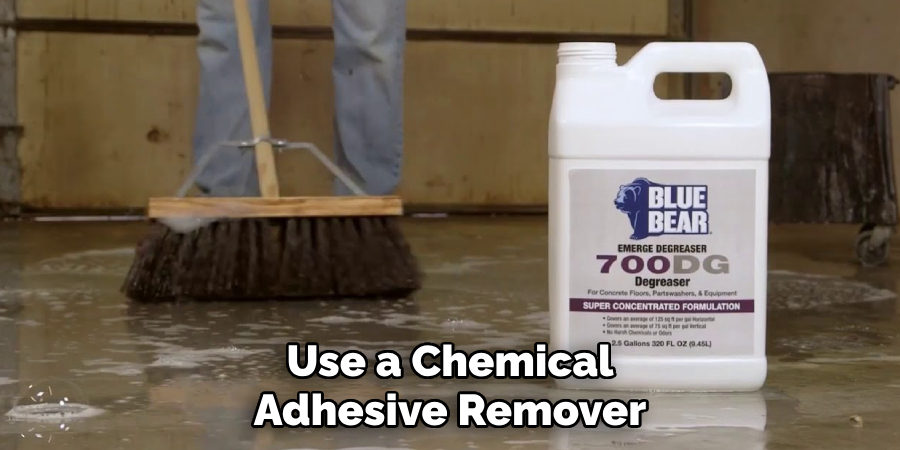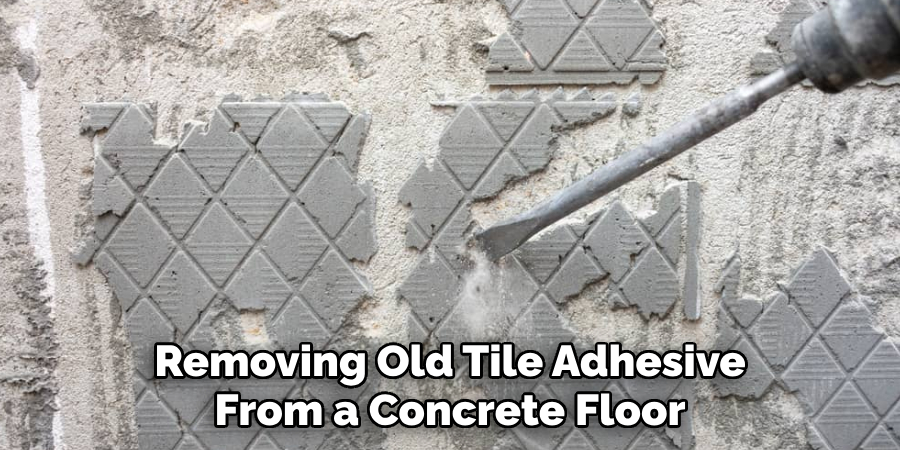Tiles may enhance the look of any floor or wall, but removing old ones can be a daunting task. And when you’re left with hardened tile adhesive stuck to the surface, you might feel like there’s no solution. But worry not, as we’ve got you covered. In this blog post, we’ll share a step-by-step guide on how to remove old tile adhesive from concrete floor. So, let’s dive right in!

Can You Remove Old Tile Adhesive from the Concrete Floor?
When renovating your home or office space, removing old tile adhesive from the concrete floor can be quite tedious. However, it is not impossible! With the right tools and techniques, you can remove old tile adhesive and give your concrete floor a fresh new look. One method is to use a floor scraper or a power grinder to remove the adhesive residue.
You can also apply a chemical adhesive remover to dissolve the adhesive and scrape it off. Of course, if the adhesive is too old or difficult to remove, seeking professional help might be necessary.
In conclusion, removing old tile adhesive can be a challenging process, but with persistence and patience, you can restore your concrete floor to its former glory.
Why Should You Remove Old Tile Adhesive from Concrete Floor?
If you’re renovating your home or business and planning on installing new tiles, it’s crucial to remove the old tile adhesive from your concrete floor beforehand. The primary reason is to ensure that your new tiles have a sturdy and stable base. Tile adhesive is designed to bond tiles to concrete floors and walls, and if it’s left on the surface, it can create an uneven base for your new tiles.
This can lead to an unattractive and bumpy finish, wasting your investment time and money. Furthermore, removing the adhesive will help prepare the surface for improved adhesion, allowing the new tiles to bond better with the concrete floor.
In conclusion, removing the old tile adhesive from your concrete floor is crucial to avoid any complications in your tile installation and ensure a long-lasting flooring solution.
How to Remove Old Tile Adhesive From Concrete Floor: A Beginner’s Guide
1. Protect Yourself and Prep the Area
Before you begin removing old tile adhesive, make sure you protect yourself. Wear safety glasses and gloves to avoid any injuries. Next, prepare the work area by removing any furniture, rugs, or decor. Then, cover nearby surfaces or objects that you can’t remove, like walls or cabinets, with drop cloths to prevent damage or staining.

2. Apply Heat
Heat is the most effective way to soften and break down the adhesive bond. You can use a heat gun or a hairdryer on high heat to warm the adhesive. Hold the heat source close to the adhesive for about thirty seconds, then move it to another section, repeating this process until you’ve heated the entire area.
3. Scrape the Adhesive
Once the adhesive is softened, it’s time to scrape it off. Use a putty knife, a scraper, or a chisel to gently loosen the adhesive from the floor. Start at an edge or corner and work your way across, careful not to gouge or damage the concrete. If the adhesive doesn’t budge, heat it again and try scraping it again.
4. Use Chemicals
You can use a chemical adhesive remover if heat and scrapping don’t work. You can find this solution at most hardware stores. Follow the manufacturer’s instructions exactly, as the chemical can be harmful if used improperly.
Apply the solution to the adhesive and leave it to penetrate for the recommended time. Then, scrape the adhesive away.

5. Clean the Area
After all the adhesive is removed, clean the area thoroughly. Use a vacuum or broom to remove any broken debris. Then, mix a water and detergent solution and scrub the surface to remove any remaining adhesive or grime. Rinse the area with clean water and let it dry completely before applying new flooring.
6. Sand the Surface
If there is still some adhesive residue left, sanding may be necessary. Use coarse-grit sandpaper to remove any remaining adhesive from the surface of the concrete. Be sure to wear a dust mask and eye protection while sanding. Once all the residue is removed, switch to finer grits of sandpaper until the surface is smooth.
7. Seal the Concrete
Once you’ve completed all the steps, it’s important to seal the concrete to prevent any remaining adhesive from seeping up through the new flooring. Use a concrete sealer and apply it according to the manufacturer’s instructions. This will also help protect the concrete from future spills or damage.
That’s it! You’ve now learned how to remove old tile adhesive from a concrete floor. Always take precautions and follow the instructions carefully, especially when using chemicals. With these steps, you can successfully remove old tile adhesive and prepare your concrete floor for new flooring installation.
5 Considerations Things When You Need to Remove Old Tile Adhesive From Concrete Floor
1. Safety
Safety should be your first consideration when removing old tile adhesive from a concrete floor. Wear protective gear such as gloves, goggles, and a dust mask to protect yourself from any particles that may become airborne during removal. Additionally, make sure the area is well-ventilated to avoid inhaling any fumes or dust created by the adhesive removal.
2. Type of Adhesive
The type of adhesive used will also play an important role in determining how it can be safely removed from a concrete floor. If the adhesive is water-soluble, then it can typically be removed with a combination of warm water and mild detergent.
However, if the adhesive is oil-based or solvent-based, more aggressive methods, such as chemical strippers or mechanical abrasion, may need to be used.
3. Size of Area
The size of the area that needs to have its tile adhesive removed will also affect the method chosen for removal. For larger areas, mechanical abrasion tools such as grinders or sanders may be necessary in order to quickly remove the adhesive in an efficient manner.
For smaller areas, chemical strippers may be more suitable as they can often remove the tile adhesive without damaging the underlying surface.

4. Power Source
Depending on which method you choose for removing old tile adhesive from a concrete floor, you may need access to an electrical power source or other specialized equipment, such as air compressors or generators, to complete the job successfully and efficiently.
Be sure to consider these requirements before beginning any project involving tile adhesive removal from a concrete floor.
5. Disposal
Finally, always remember that when removing old tile adhesive from a concrete floor, there will likely be some debris created by the process that must be disposed of properly in accordance with local regulations and laws regarding hazardous materials disposal.
Taking care of this aspect ahead of time will help ensure that your project is completed safely and responsibly with minimal disruption or environmental impact.
Benefits of Remove Old Tile Adhesive From Concrete Floor
Removing old tile adhesive from a concrete floor may seem daunting, but the benefits are well worth the effort. Over time, old adhesive can become brittle, crack, and even detach from the floor. This can negatively impact the floor’s appearance and even make it unsafe to walk on.
By removing the old adhesive and preparing the surface properly, a new layer of adhesive can be applied to create a secure, durable, and attractive flooring surface.

Additionally, removing the old adhesive can help to improve indoor air quality by eliminating dust and possible harmful contaminants. Overall, taking the time to remove old tile adhesive from a concrete floor can enhance your space’s appearance, ensure safety, and promote better health.
Some Common Mistakes People Make When Trying to Remove Old Tile Adhesive From Concrete Floor
Removing old tile adhesive from a concrete floor can be a difficult and frustrating task. Unfortunately, there are common mistakes that people often make that can make the job even more challenging. One of the biggest mistakes is not properly preparing the floor before attempting to remove the adhesive. This can include not cleaning the floor thoroughly or smoothing any bumps or uneven surfaces.
Another mistake is using the wrong tools or techniques for the job. Using a too sharp scraper, for example, can damage the concrete floor, while not using enough adhesive remover can result in spending hours on a task that only takes minutes. By avoiding these common mistakes, you can save time and energy when removing old tile adhesive from your concrete floor.
Conclusion
Removing old tile adhesive from a concrete floor can be tough, but it’s not impossible. You can get the job done by following these five simple steps – protecting yourself, applying heat, scrapping the adhesive, using chemicals, and cleaning the area. Remember to take your time, work carefully, and follow all safety precautions.
And if you feel like you can’t handle the task alone, don’t hesitate to call in the professionals. We hope this blog post has been helpful and that your newly restored concrete floor is now ready to shine! Thanks for reading our post about how to remove old tile adhesive from concrete floor.
